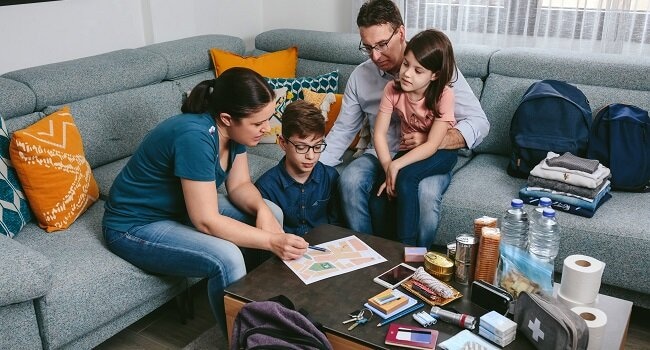An emergency is any unexpected event that poses a risk to your safety and well-being. It could be a natural disaster like a hurricane, a power outage, or even a health crisis. These events often come without warning, leaving little time to respond. That’s why understanding what an emergency is becomes crucial.
Being prepared equips you with the knowledge and tools to handle unforeseen situations effectively. In emergencies, every second counts. Preparedness can reduce panic, mitigate risks, and can even be life-saving. It’s about having a plan, knowing what to do, and having the resources ready. This preparation turns fear into confidence and chaos into order. Explore below what it takes to be truly prepared.
1. Assessing Personal And Family Needs
Assessing your personal and family needs is a vital step in emergency preparedness. Start by evaluating the unique needs of each family member. Consider age, medical conditions, and daily medications. This assessment ensures everyone’s specific needs are addressed in your plan.
For families with special needs members, extra attention is key. Tailor your plan to include necessary medical equipment, accessible evacuation routes, and effective communication methods. Don’t forget your pets. They need a plan too. Ensure you have pet food, carriers, and their medical records.
Children require special consideration as well. Teach them about emergencies in a way that’s easy to understand. Include comforting items like toys in your emergency kit. This thoughtful planning ensures everyone, regardless of age or ability, is safe and accounted for during an emergency.
2. Insurance
In your emergency preparedness plan, don’t overlook the role of insurance. It’s a critical component in safeguarding your financial stability during and after emergencies. Key to this is personal accident insurance. This specific insurance covers expenses resulting from accidents that lead to injury or death.
Personal accident insurance offers a safety net. It helps manage costs from unforeseen injuries, ensuring financial burdens don’t add to your stress during crises. Along with this, review your home and health insurance policies. Ensure they cover risks relevant to your area, like natural disasters or health emergencies.
Regularly updating your insurance policies is as important as maintaining your emergency kit. Life changes, and so do your insurance needs. Doing so protects your future against the unpredictable.
3. Creating An Emergency Communication Plan
An effective emergency communication plan is your lifeline during crises. Start by identifying a family contact outside your immediate area. This person can help relay messages if local lines are overloaded. Next, establish a family meeting place in case you can’t return home. Choose one location nearby and another further away.
Ensure everyone knows these locations and the contact person’s details. Teach all family members how to send text messages. Texts can often get through even when calls can’t. Also, agree on a safe word or phrase to convey your status discreetly.
Stay informed during emergencies by having a battery-powered or hand-crank radio. Subscribe to local alert services for real-time updates. This proactive approach keeps you connected and informed, making a significant difference in an emergency.
4. Building An Emergency Kit: Essentials And Beyond
A well-stocked emergency kit is a cornerstone of preparedness. At its core, your kit should include water (one gallon per person per day for at least three days), non-perishable food for three days, a flashlight with extra batteries, a first aid kit, and a whistle to signal for help. Don’t forget personal hygiene items, face masks, and hand sanitizer.
Beyond the essentials, tailor your kit to your specific needs. If you have prescription or over-the-counter medications, include a week’s supply. For those in regions prone to natural disasters, like earthquakes or hurricanes, add appropriate items. This could be a wrench to turn off utilities or a fire extinguisher.
Remember, your emergency kit is not static. Regularly check and update it. This ensures you’re always prepared, no matter what the situation.
5. Home And Personal Safety Strategies
Securing your home against emergencies is a proactive step towards safety. Start by reinforcing your home’s structure. Secure heavy furniture and appliances to walls to prevent tipping during earthquakes. Check smoke and carbon monoxide detectors regularly to ensure they’re functioning. Know how to turn off your home’s utilities, like gas and water, to prevent additional hazards.
For personal safety, educate yourself on basic first aid and CPR. This knowledge can be crucial in a crisis. In fire emergencies, practice escape routes with your family. If you live in areas prone to natural disasters, understand and prepare for the specific risks associated with them.
Remember, your safety plan should be dynamic, adapting to changing circumstances and needs. Regular drills and discussions with your family can keep everyone aware and prepared.
6. Emergency Skills And Training
Acquiring basic first aid and emergency response skills is crucial. These skills empower you to respond effectively in critical situations. Knowing how to perform CPR, treat wounds, or handle a choking incident can save lives.
Numerous resources are available for acquiring these skills. Community centers often offer first aid and CPR classes. The American Red Cross and other similar organizations provide training sessions, both in-person and online. Local fire departments sometimes host emergency response workshops.
Investing time in this training is invaluable. It prepares you for emergencies at home and in public spaces. Equipped with these skills, you become an asset to your community in times of crisis. In emergencies, your knowledge can make all the difference.
Conclusion
Building a personal emergency preparedness plan through these steps helps you prepare for the unforeseen. Review and apply them to your situation. Remember, preparedness is a continuous process. Join community preparedness programs to stay engaged and informed. These programs offer valuable resources and can connect you with others who share your commitment to safety.

Additionally, subscribe to emergency alert services. They provide timely information during crises. This proactive approach ensures your well-being and empowers you to help others in times of need.


















